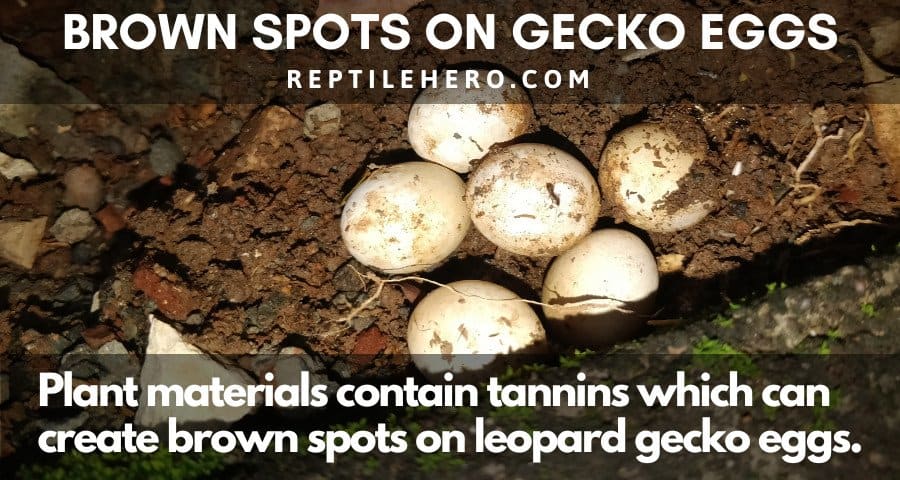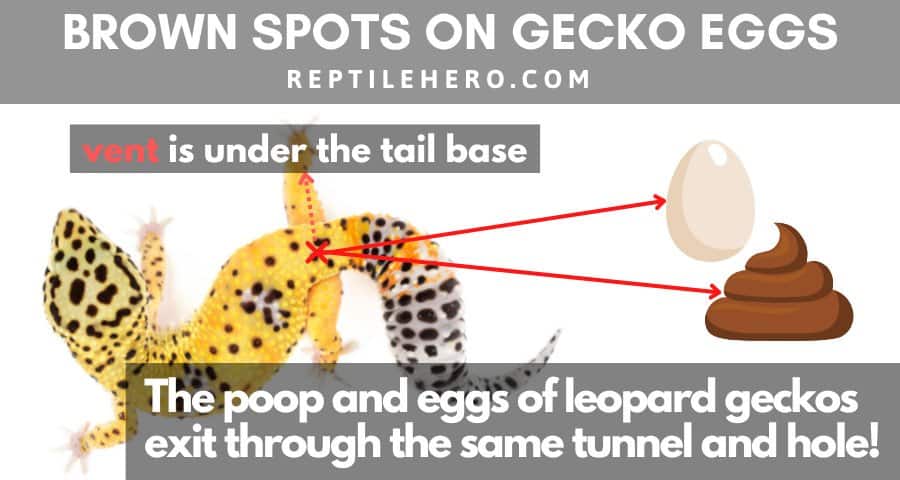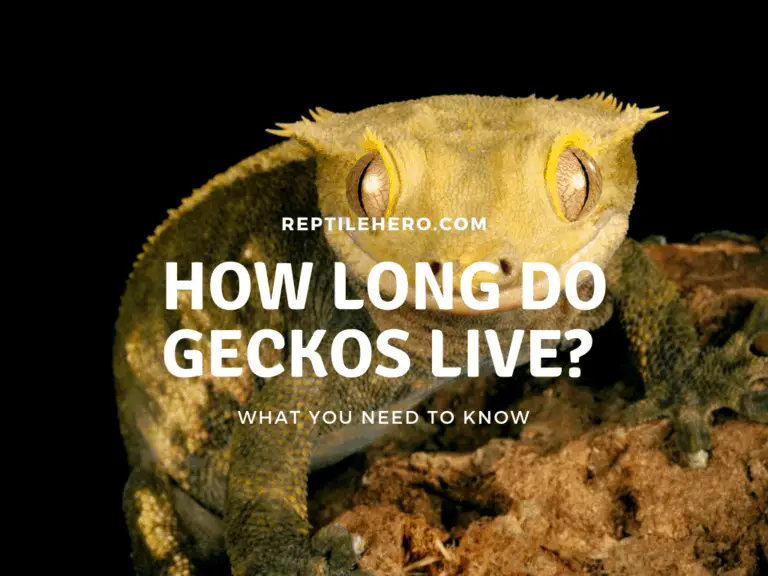5 Causes of Brown Spots on Leopard Gecko Eggs! Normal or Dud?
It’s never easy to come to the decision of keeping and incubating unexpected leopard gecko eggs. So suddenly noticing weird brown patches and markings on their shells can be incredibly worrying. This can also be alarming for pet parents who have only recently decided to breed their geckos. But are brown spots and dark patterns always a bad sign?
Leopard gecko eggs can develop brown spots and marks due to 1) substrate contact, 2) feeder insects, 3) droppings, 4) mold growth, and 5) dried blood. Such dark stains on shells aren’t necessarily a sign of any serious problem. However, in some cases, for instance, browning due to bleeding can point to illness in the adult gecko.
Now, to be clear, keep in mind that eggs with brown spots are not unique to leos. You may see them in other species as well, including cresties and tokays. Keep scrolling to learn more!
1. Substrate
Even normal leopard gecko eggs can have brown spots on their shells after being laid and incubated in moist wood-containing substrates like coco fiber. This is normal and should not be any cause for concern.
Unlike other tree-dwelling species that produce hard-shelled eggs that can simply stick to trees and walls, leopard geckos dig into the ground to bury their eggs. Others look for dry but humid spaces in big rocks to keep the eggs safe and increase their chances for survival.
Either way, a wild leo’s eggs are bound to come into direct contact with dirt and soil in the wild. In captivity, we try to replicate this by giving them a lay box for safe deposition. Then, we collect the eggs and place them in an incubator with a moist substrate.
Many pet parents have also transitioned into adding deep soil-based substrates into their gecko enclosures along with live plants, providing a bioactive environment for their babies. In such instances, leos have been found digging and laying straight into the substrate.
Find out which are good and bad choices in our article on the best gecko substrates!
So it shouldn’t really come as a surprise that their eggs often don’t retain a pearly white appearance. Besides getting a speckled look from all the bits of soil and coco fiber, gecko eggs may also get brown spots from a compound found in various plant materials.

Tannins are a type of chemical naturally occurring in flowering woody plants, found in virtually all parts of plants, from the roots to the fruits [1]. Although it mainly works as a pest deterrent, it is also commonly used for dyeing a wide variety of products and making ink.
When sold commercially, you may find them as yellow-brown substances which—as you might’ve already guessed—produce different shades or brown dyes. But they don’t even need to be isolated to have an effect, which brings us to the topic at hand.
Many natural decors, like cork tubes and wooden branches, and natural substrates, such as soil, orchid bark, coco coir, fern fiber, and mulch, can stain leopard gecko eggs brown because they contain tannins.
What I find more interesting though is that tannins can react differently when exposed to other compounds. Mixing iron salts with tannins and create deep blue or green hues instead of the normal brown.
2. Insects
Insects and their bodily juices can create brown splotches and markings on leopard gecko eggs. Although such spots may be unsightly, they don’t pose a serious issue. Moreover, brown spotting on eggs due to insects are easy to wipe off if necessary.
No matter how much we love our cute little leos, we can’t deny the fact that they are messy eaters. They take one big chomp of their live feeder insects at a time. So as you can imagine, internal juices will fly out as they bite down on whatever insect you offer them.
When they eat near a newly laid egg or you haven’t noticed that they’ve already passed an egg or two, those dark liquids from their guts can spurt out and land on the eggshells.
I’ve also heard of stories where, upon a closer look, gecko owners realize that the brown spots and lines on their leo’s eggs are actually wiggling around. As it turns out, they were baby mealworms, laid by an uneaten feeder!
Discover the risks of leaving live feeders in the tank!
Having live insects and their bodily liquids on your gecko’s egg won’t really cause any problems, especially if you’re going to transfer them into a proper incubating container soon. Then again, it’s won’t look the best.
So if this is an issue for you, you can simply gently wipe brown insect stains with a moist paper towel or cloth. Just be very careful while doing this since a leopard gecko’s eggs are not the hard-shelled type, like chicken eggs, that we’re more familiar with.
3. Droppings
Leopard gecko eggs may have brown stains due to droppings as they are laid since a gecko’s digestive and reproductive tracts both end in the cloaca. This can be easily removed with a wet towel.
Unlike humans who have separate holes for peeing, pooping, and birthing, geckos only have one which is probably familiar to you as they vent. A leopard gecko’s vent is found right under its tail base.
Now, of course, before going through to the vent and going into the outside world, your gecko’s poo, urates, and eggs will have to pass through a final tunnel. This tunnel is called the cloaca in not only geckos but many other reptiles.

Similar to chickens, it’s quite normal for leopard gecko eggs to have brown splotches once they’re laid because of leftover feces in the cloaca.
Don’t worry, though! Having these stains on your gecko’s eggs won’t easily kill the baby leo growing inside.
Nevertheless, if you aren’t a fan of having droppings paint your lovely leo’s precious eggs, you can just remove it with a wet paper towel. Alcohol-free unscented baby wipes will work too. You don’t need to clean it off using soap of any kind.
When kept in a humid environment, however, a leopard gecko egg with traces of poop can develop molds. This brings us to the next cause of brown marks!
4. Mold
When left dirty and uncollected in a highly humid tank, leopard gecko eggs may develop mold which looks like fuzzy brown spots. Such eggs can still hatch if treated promptly.
If the egg has only been recently laid by your soft-scaled leopard gecko, then the brown spots on it are unlikely due to mold growth.
So a one-day-old egg is more likely to have markings on it due to the earlier causes I mentioned than molding.
More often than not, a gecko egg will have mold form on it after several days or weeks. This can happen if you don’t collect the eggs and just leave them in your gecko’s tank.
But I wouldn’t necessarily fault you for this. Many new gecko owners don’t even realize that they have an adult female leo with them so they don’t even expect to see any eggs at all.
Other times, incorrect incubation conditions can lead to the development of mold as well. So if you do decide to keep and hatch your gecko’s eggs, make sure to do your research on how to incubate leopard gecko eggs properly!
Simply put, various things can cause brown mold spots to form on your leo’s eggs. Even then, you can still clean and save them by collecting them and correcting their incubating condition.
Learn how to treat them properly in our article on moldy gecko eggs.
Otherwise, your moldy gecko eggs will no longer hatch as the baby inside it may have already stopped growing and could have already died due to neglect.
5. Dried Blood
In rare cases, a leopard gecko’s egg may have brown marks because of dried blood. This may be from internal issues, like hemorrhage, and external injuries. Exotic veterinary attention is needed for proper diagnosis and treatment in such instances.
Although uncommon, leopard gecko eggs with dried blood spots are not completely unheard of. Unfortunately, out of all the causes of brown markings, this is can be incredibly bad!
Once you do notice that your gecko’s eggs have dried blood stains on them, check her physically for injuries. Closely inspect its toes, belly, vent, and tail for cuts and wounds.
When you find the injury, gently disinfect it to prevent infections. A shallow and warm povidone-iodine bath can be great for such cases. Then, put some silver sulfadiazine (here on Amazon) on the wound and keep your injured leo in a hospital tank until it heals.
But if you’re gecko only lays one blood-stained egg and she’s acting unusually, the brown spot may be a sign of something more serious—deadly, even.
Oftentimes, brown blood spots on leopard gecko eggs are due to internal trauma from falls as well as egg-binding complications [2, 3]. In these cases, there’s almost always one egg that still hasn’t been laid.
Don’t force retained egg out by massaging your little lady’s belly. This could do more harm than good, possibly causing hemorrhaging and prolapse.
Massaging your gecko’s belly while there’s still an egg inside its oviducts could also cause it to break and leak its contents inside your leo’s body. As you could imagine, this can be very dangerous.
Rather than trying to deal with such potentially fatal conditions at home, quickly call up your local exotic vet. If possible, they could even give you tips that could help your gecko feel more comfortable at home while waiting for your appointment date.
Are All Leopard Gecko Eggs With Brown Spots Duds?
Unless a leopard gecko egg has become completely discolored, smelly, and malformed, minor brown spots are not a sign of a dud or infertile egg. More often than not, a healthy leopard gecko baby will hatch from an egg with brown spots.
Normally, leopard gecko eggs have a white leathery, or parchment-like, shell. However, the egg’s appearance won’t always be able to tell you whether or not it’s fertile.
Like chicken eggs, gecko eggs may stay pearly white throughout the incubation period and only end up rotting after several weeks. No worries, though!
You can easily check for signs of life and see if the embryo in the egg is developing normally or not, and if it’s a dud with a regular flashlight by candling your leopard gecko’s eggs.
A good fertile leopard gecko egg that’s growing will develop a dark red ring and visible blood vessels as time passes. You might even see the small leo moving when you check it!
The same is true for brown-spotted leopard gecko eggs as well. Having stains and marks is not a definitive sign that the egg is not viable. In fact, even moldy and dented eggs have hatched healthy babies.
Further Questions
What could kill gecko eggs?
Many factors can lead to the death of a developing leopard gecko embryo inside the egg. Inappropriate temperatures and humidity levels are the two most common incubation issues that kill gecko eggs. Other causes of egg mortality include infections and failure to hatch. A necropsy will help determine the exact cause of death.
How long do reptiles lay eggs?
A female leopard gecko will normally finish laying its eggs within 24 hours much like many other commonly kept reptile pets such as snakes and turtles. Signs that a gecko is about to lay eggs include digging, straining, restlessness, and refusal to eat. In most cases, the female will act normally again after successfully laying its clutch of eggs.
Summary of Brown Spots on Leopard Gecko Eggs
The eggs of female leopard geckos may have brown spots and other dark-colored stains on them because of direct contact with the loose substrate, insects and their juices, leftover poop in the cloaca, mold growth, and bleeding before or after one or both eggs are laid.
More often than not, brown markings on leopard gecko eggs are normal and don’t negatively affect the developing baby inside. However, brown spots due to mold and blood may be a sign of serious problems. When left untreated, the baby and/or mother can die as a result. As such, proper veterinary care is necessary.
Sources
[1] https://www.britannica.com/science/tannin

![4 Reasons Why Leopard Geckos Get Neutered [and Problems]](https://www.reptilehero.com/wp-content/uploads/2021/04/Can-Gecko-Get-Neutered-768x614.jpg)
![Choose the Right Thermostat for Your Gecko Tank [7 Factors]](https://www.reptilehero.com/wp-content/uploads/2021/09/choose-gecko-tank-thermostat-small-cover-infographic.jpg)
![Can You Have a Gecko and a Cat Together? [Yes, But…]](https://www.reptilehero.com/wp-content/uploads/2021/11/Gecko-and-cat-together-cc-768x614.jpg)

![5 Steps To Calm Down A Gecko [+4 Simple Tips]](https://www.reptilehero.com/wp-content/uploads/2021/12/calm-down-gecko-cc-768x614.jpg)
